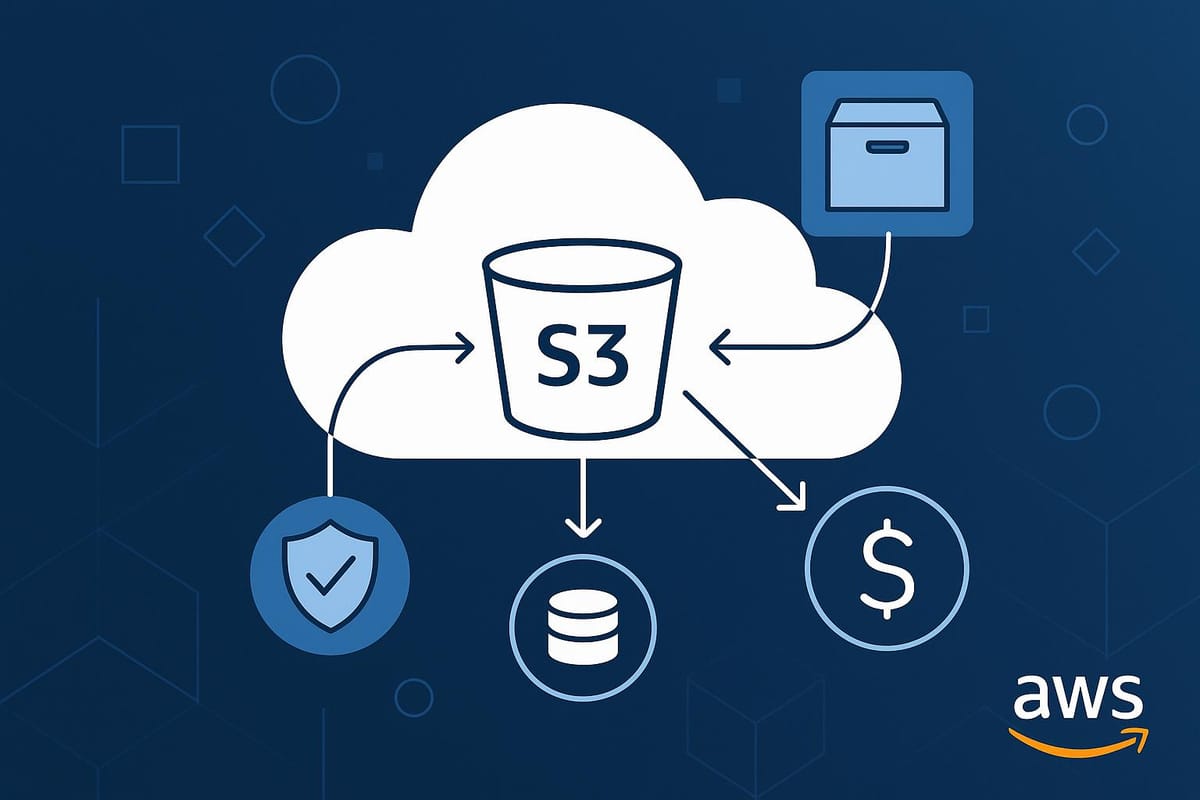S3 Lifecycle Rules: Cost-Saving Tips
Explore how S3 Lifecycle rules can automate data management, reduce costs, and ensure compliance with UK GDPR for businesses.

Managing storage costs while meeting data retention policies can be challenging for UK businesses. Amazon S3 Lifecycle rules automate cost-saving actions by moving data to cheaper storage classes or deleting it when no longer needed. Here's how they help:
- Transition Data: Automatically move files to lower-cost storage classes like S3 Glacier or Deep Archive.
- Expire Data: Delete files that are no longer required, aligning with compliance rules.
- Cost Savings: Reduce storage expenses by up to 95% with Deep Archive.
Key Storage Classes & Costs
| Storage Class | Cost (£/GB/month) | Retrieval Time | Minimum Duration |
|---|---|---|---|
| S3 Standard | £0.023 | Milliseconds | None |
| S3 Intelligent-Tiering | £0.021* | Milliseconds | None |
| S3 Standard-IA | £0.0125 | Milliseconds | 30 days |
| S3 Glacier Instant | £0.004 | Milliseconds | 90 days |
| S3 Glacier Deep Archive | £0.00099 | 12–48 hours | 180 days |
*Base pricing, excluding monitoring fees.
Why It Matters
- Save Money: Businesses like Comply saved over £368,000 by implementing lifecycle rules.
- Stay Compliant: Automate data retention policies to meet UK GDPR requirements.
- Immediate Impact: Apply rules to existing and new data for instant optimisation.
Want to cut storage costs and simplify compliance? Start with S3 Lifecycle rules today.
S3 Storage Classes and Pricing
S3 Storage Class Types
Amazon S3 provides a range of storage classes designed to balance cost, performance, and availability based on your specific needs. Whether you're managing frequently accessed data or long-term archives, there's an option tailored for your use case.
S3 Standard is the default choice, offering high availability and durability. It's perfect for data that requires frequent access, such as content for active websites, mobile apps, or gaming resources.
S3 Intelligent-Tiering stands out by automatically shifting data between access tiers depending on usage patterns. Since its introduction in 2018, this feature has helped customers cut storage expenses significantly. For instance, savings include:
- 40% on the Infrequent Access tier
- 68% on the Archive Instant Access tier
- 95% on the Deep Archive tier
For less frequently accessed data, S3 Standard-IA and S3 One Zone-IA are cost-effective alternatives. The One Zone-IA variant stores data in a single availability zone and is 20% cheaper than Standard-IA. Both options require a minimum storage commitment of 30 days and a minimum object size of 128 KB.
When it comes to archival storage, Amazon S3 Glacier offers several options:
- Glacier Instant Retrieval for archives needing quick access
- Glacier Flexible Retrieval for data accessed 1–2 times per year
- Glacier Deep Archive, the most affordable choice, with retrieval times ranging from 12 to 48 hours
Understanding these storage classes is essential when planning cost-saving strategies, particularly as we dive into their pricing structures.
Storage Class Price Comparison
The pricing differences between storage classes play a significant role in cost management:
| Storage Class | Cost (£ per GB/month)* | Retrieval Time | Minimum Storage Duration |
|---|---|---|---|
| S3 Standard | £0.023 | Milliseconds | None |
| S3 Intelligent-Tiering | £0.021** | Milliseconds | None |
| S3 Standard-IA | £0.0125 | Milliseconds | 30 days |
| S3 One Zone-IA | £0.010 | Milliseconds | 30 days |
| S3 Glacier Instant | £0.004 | Milliseconds | 90 days |
| S3 Glacier Deep Archive | £0.00099 | 12–48 hours | 180 days |
*Prices are approximate and may vary by region
**Base tier pricing, excluding monitoring fees
"With the cloud, you can start as an experiment, make sure you can make it work, and then roll it out across the larger organization. And if something fails, you wouldn't lose the fixed costs of IT infrastructure." – Wang Jin, Massachusetts Institute of Technology Researcher
For organisations seeking the most cost-effective archival storage, S3 Glacier Deep Archive is a standout option, offering prices up to 75% lower than Glacier Flexible Retrieval. However, it's worth noting that Glacier storage classes include an additional charge for 40 KB of metadata per archived object.
Given that storage costs often dominate S3 budgets, understanding access patterns is essential for selecting the right storage classes and keeping expenses under control.
How to set up S3 Lifecycle Rules to save on S3 costs
Setting Up S3 Lifecycle Rules
Automating lifecycle rules in S3 is a smart way to cut costs and stay compliant with storage policies.
Creating Transition Rules
Transition rules help you automatically move objects between storage classes based on specific conditions.
- Define Target Objects: Use attributes like prefixes, tags, or object size to identify which objects the rules should apply to.
- Set Transition Timing: Decide when objects should move to different storage classes. For instance, you might first transition files to S3 Standard-Infrequent Access and later to S3 Glacier Deep Archive for long-term storage. Keep in mind that transitioning data comes with a one-time cost.
Transition rules work hand in hand with expiration rules to create a full lifecycle management strategy.
Creating Expiration Rules
Expiration rules are designed to automatically delete objects after a set period.
- Align expiration criteria with your retention policies.
- For versioned buckets, note that delete markers are added instead of immediately removing objects.
- Always confirm compliance requirements before implementing deletion rules.
Rule Setup Tips
Once you’ve created transition and expiration rules, consider these best practices to maximise efficiency:
- Use S3 Storage Class Analysis to get insights into access patterns.
- Keep an eye on transition costs to avoid surprises.
- Maintain consistent object tagging and enable bucket versioning to protect your data.
- Take advantage of S3 Intelligent-Tiering to automate tiering and avoid unnecessary expenses.
- Plan transitions to Glacier storage classes carefully for long-term cost savings.
Next, we'll dive into additional methods to help you further reduce your S3 storage costs.
Cost Reduction Techniques
Storage Class Transitions
Using multi-tier storage strategies can lead to substantial savings. For instance, a company managing 75 TB of data cut their monthly expenses from £1,380 to £750 simply by transitioning from S3 Standard to S3 Standard-IA. While this shift incurred a one-time cost of £400, the monthly savings of £630 quickly made up for it.
Here’s how much you can save with tiering:
- Up to 40% savings: Move objects to the Infrequent Access tier after 30 days.
- Up to 68% savings: Use the Archive Instant Access tier for objects older than 90 days.
- Up to 95% savings: Transition to the Deep Archive Access tier after 180 days.
Additionally, optimising file sizes can further reduce costs beyond just choosing the right storage class.
File Size Filters
Focusing on large, high-cost files can unlock further savings. When setting up size-based filters, keep these points in mind:
- Use the ObjectSizeGreaterThan and ObjectSizeLessThan parameters to define size ranges.
- Specify sizes in bytes, with a maximum filter size of 5 TB.
- Ensure the minimum size is smaller than the maximum size in your range.
For Glacier storage classes, it’s worth aggregating smaller files before archiving. This helps reduce transition costs and overhead, as Glacier classes charge for an additional 40 KB of metadata per object.
Pair these techniques with strong cost monitoring for the best results.
Cost Tracking Tools
Effective cost management requires thorough monitoring. Tools like S3 Storage Lens provide deep insights with over 30 metrics, including object counts, average sizes, and details on operations like PUT, GET, and LIST. This visibility helps you understand storage patterns and identify opportunities to optimise transitions.
Consider these tools for cost tracking:
- AWS Cost Explorer: For basic expense tracking.
- S3 Storage Lens: For detailed analytics and metrics.
- AWS Budgets: To set up proactive cost alerts.
Additionally, S3 Storage Class Analysis can help pinpoint the right time for transitions by studying access patterns. This ensures lifecycle rules align with usage, avoiding unnecessary retrieval fees.
Meeting Compliance Requirements
Data Retention Rules
Under the UK GDPR, personal data should only be kept for as long as it's needed for lawful purposes. Organisations can establish lifecycle rules to automatically delete personal data after the required six-year retention period. These lifecycle policies should align with internal retention standards and legal obligations. Tools like Amazon Macie can help identify personal data stored in S3 buckets, ensuring sensitive information is managed correctly with appropriate lifecycle rules. Additionally, it's crucial to maintain a reliable audit trail to confirm these retention processes are followed.
Audit Trail Setup
A well-maintained audit trail is essential for demonstrating compliance with UK GDPR. AWS CloudTrail provides detailed logs of S3 activities, making it a valuable tool for tracking and verifying compliance. To set up a robust audit system:
- Enable S3 server access logging to capture lifecycle-related actions.
- Configure CloudTrail to log data events for your S3 buckets.
- Set up CloudWatch alerts to flag unusual activities.
"The transparency provided by comprehensive logging is one of the cloud's most consequential security and compliance benefits." – Hannah Grace Holladay, Content Marketing Specialist, KirkpatrickPrice
For effective audit trail management, store your CloudTrail logs in a dedicated S3 bucket. Ensure the bucket has encryption enabled (using KMS CMKs), follows least-privileged access principles, has CloudTrail Log File Integrity Validation turned on, and includes a defined retention policy. Once the audit system is in place, implement legal hold controls to safeguard sensitive data.
Legal Hold Controls
When managing data with S3 lifecycle rules, it's vital to protect legally sensitive information from being automatically deleted. S3 Object Lock offers a Write Once Read Many (WORM) model, which prevents objects from being deleted or overwritten during legal proceedings. To implement legal hold controls effectively:
- Enable S3 Versioning and use Governance mode to allow controlled changes to retention settings.
- Apply Legal Hold to specific object versions as required.
- Use S3 Batch Operations for applying legal holds to multiple objects at once.
These legal hold controls work independently of retention periods, applying to individual object versions. This ensures precise compliance without incurring additional storage costs.
Summary
S3 lifecycle rules can deliver impressive cost savings while helping organisations meet data retention requirements. By strategically transitioning data across storage classes, businesses can cut costs significantly - up to 95% with the Deep Archive Access tier and 68% with the Archive Instant Access tier.
Practical examples highlight the value of these lifecycle rules. Zalando, for instance, reduced its annual storage costs by 37% by automatically moving inactive objects to the infrequent-access tier after 30 days. Similarly, Pomelo estimates it will save 40–50% on storage expenses by leveraging Amazon S3 Glacier storage classes.
To replicate such successes, consider these strategies:
- Analyse Access Patterns: Track data usage trends to align storage decisions with actual access needs.
- Start Simple: Begin with straightforward transition rules before introducing more complex configurations.
- Test Thoroughly: Experiment in non-production environments to ensure smooth implementation.
- Monitor and Optimise: Use tools like S3 Storage Lens and AWS Budgets to track performance and uncover further savings opportunities.
Regularly revisiting and refining your lifecycle policies is essential to maintain savings and ensure compliance with regulations like UK GDPR. By pairing automated transitions with monitoring tools, organisations can strike a balance between reducing costs and maintaining data governance.
Teespring provides another compelling example, cutting monthly storage costs by over 30% through the use of S3 Glacier and Intelligent-Tiering. These cases underscore the real-world benefits of well-designed and consistently managed lifecycle rules.
FAQs
What is the best S3 storage class to save costs while staying compliant with UK GDPR?
Choosing the right S3 storage class comes down to how often you need to access your data and how long you plan to keep it. For data that's accessed frequently, S3 Standard is a solid option. If your access patterns tend to fluctuate, S3 Intelligent-Tiering can help by automatically adjusting to optimise costs. For data you rarely need but want to store long-term, S3 Glacier or S3 Glacier Deep Archive can cut storage expenses by as much as 95%.
To save even more and stay compliant with UK GDPR, you can take advantage of S3 Lifecycle Policies. These policies let you automate the transfer of data between storage classes based on its age or how often it's accessed. For instance, you could configure data to move to S3 Glacier after a set period, ensuring you're only paying for what you use while adhering to retention regulations.
What costs should I consider when moving data between S3 storage classes, and how can I minimise them?
When moving data between Amazon S3 storage classes, there are a few costs you need to keep in mind. For instance, each transition request is priced at about £0.01 per 1,000 requests. So, if you're transferring 50 million files, that would set you back approximately £500. While storage classes like S3 Standard-IA offer lower storage costs, they often come with higher retrieval fees.
To keep these costs under control, consider using S3 Lifecycle Policies. These policies automate data transitions based on how often the data is accessed. Frequently accessed files can remain in higher-cost storage classes, while less-used data is automatically moved to more economical options like S3 Glacier. This method not only cuts down on expenses but also ensures you stay aligned with data retention requirements.
How can S3 Lifecycle rules help UK businesses comply with GDPR while managing storage costs?
S3 Lifecycle Rules: Simplifying Data Management and Compliance
S3 Lifecycle rules give UK businesses a practical way to automate data management while staying compliant with GDPR. By setting specific retention periods for personal data, these rules ensure that information is either archived or deleted when it’s no longer required. This approach not only helps businesses meet legal obligations but also reduces unnecessary storage expenses.
What’s more, S3 Lifecycle rules can work hand-in-hand with AWS CloudTrail. This integration allows organisations to monitor data access and modifications, creating a detailed audit trail. Such records are invaluable during compliance audits and can also help pinpoint potential security vulnerabilities. By automating these tasks, companies can effectively manage the tricky balance between meeting regulatory demands and keeping costs under control.




